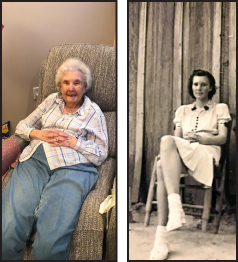By Bonita Wilborn
When America’s men left to fight with the Allies in World War II, women were recruited through posters and other propaganda to work non-traditional jobs in defense plants and factories.
The character of “Rosie the Riveter” first began as a song inspired by war worker Rosalind P. Walter. After high school, 19-year-old Rosalind began working as a riveter on Corsair fighter planes at the Vought Aircraft Company in Stratford, Connecticut. After a newspaper article featuring Rosalind’s work was published, songwriters Redd Evans and John Jacob Loeb were inspired to write the song “Rosie the Riveter.” With the release of this song, the concept of Rosie the Riveter became a part of public consciousness.
It should be noted that while Rosalind may have been the first, there were many other “real-life Rosies” throughout the war. Rosie the Riveter became a symbol of all women working in the war industries during World War II. After the release of the song inspired by Rosalind, the image of Rosie the Riveter became further cemented in the public imagination, largely due to the circulation of illustrations and propaganda.
Many women had always held jobs outside the home, but this was the first time they were paid well and taught skilled labor. Many other women had not held a paying job outside of their homes, and this was a new experience to earn money for their hard work. These “Rosie the Riveters”, as they were referred to by many, proved their abilities to America and themselves and have not looked back since.
One real-life Rosie the Riveter was born and raised, at least for the first few years of her life, right here on Sand Mountain in northeast Alabama. It is 99-year-old Marie Chapman Hurst, a current resident at Wills Creek Village in Fort Payne.
Marie began, “I was born on Sand Mountain, and I guess I was about twelve when we went to Atlanta.” Due to her parents’ divorce, Marie, her mother, and her sister lived in the Ider/Cartersville area with her grandparents. The grandfather was one of the first in the area to have an automobile. “And I learned to drive,” Marie recalled with a smile.
As a young child, Marie would routinely walk the Cove Gap at night, so even as a child, she was somewhat fearless. “You’d take a shortcut through the graveyard, or you went a long way around. So I took the shortcut. I was afraid, but I went through there like a lightning streak.”
During World War II, when Marie was in her late teens, 16 or 17, the nation needed workers in its defense plants. In Marietta, Georgia, there was a defense plant where B29s that had flown missions in the war were taken for needed repairs. It was an underground facility. Those making those necessary repairs had to climb in, on, around, and over the aircraft, ensuring that all the missing rivets were replaced so that the plane was safe for another mission.
“We had a terrible time trying to find shoes that didn’t mark the skins on the airplanes. If marked at all, they had to be cleaned. So finally, in some little town, we found little boys shoes that didn’t mark the airplanes. So we wore little boys shoes because we had to climb all over those planes,” Marie recalled.
When asked if it was hard work, Marie replied, “I didn’t think so. I worked on a farm, so I don’t remember it being especially hard. I loved it.”
Marie had an uncle who worked with the government, and as best she could remember, she got her job through his connections. But, jobs at defense plants at that time were generally not hard to come by for women, as all the young, able-bodied men were fighting in the war far from home. “There were very few men, and if they were any men, they were old,” Marie said.
Marie’s job in the defense plant ended with the conclusion of the War on September 2, 1945. “They laid us all off that day with no money, no pension, and no job.”
After Marie’s job in the defense plant ended (at approximately 18), she met and married the love of her life, James Hurst.
They had two sons named Wayne and Gerald. “They were just regular boys,” Marie continued. “They both loved to play ball and things like that.”
James and Wayne both served their country in the United States military, but Gerald had a degenerative issue that affected his back and had to have a rod placed in his spine at a young age, so he was not eligible, although he tried to join the Marines and was turned down. Wayne served in the Vietnam War era and was wounded in the military multiple times, receiving two or three purple hearts. James served in the United States Navy. Wayne and Gerald both made their living as electricians.
However, neither of her sons had children, so Marie has no grandchildren. Her branch of the Hurst family ends with Marie.
Marie’s work ethic dictated that she was not a normal housewife and stay-at-home mom, as was very prevalent in that era. “I never had any problem getting a job. I always worked,” she said. Marie first opted to attend beauty school, but a severe allergy to the chemicals made that an impossible career. Marie’s niece, Barbara stated, “Her last 25 years to work; she was head over the housekeeping department of Georgia Mental Health.
That’s where she retired from.”
We at MVN would like to thank Marie and all the other “Rosie the Riveters” who worked hard for their country during wartime and peacetime.



